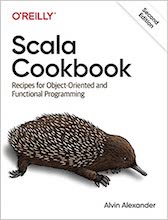|
|
Java example source code file (OrderedCrossoverTest.java)
This example Java source code file (OrderedCrossoverTest.java) is included in the alvinalexander.com
"Java Source Code
Warehouse" project. The intent of this project is to help you "Learn
Java by Example" TM.
Learn more about this Java project at its project page.
The OrderedCrossoverTest.java Java example source code
/*
* Licensed to the Apache Software Foundation (ASF) under one or more
* contributor license agreements. See the NOTICE file distributed with
* this work for additional information regarding copyright ownership.
* The ASF licenses this file to You under the Apache License, Version 2.0
* (the "License"); you may not use this file except in compliance with
* the License. You may obtain a copy of the License at
*
* http://www.apache.org/licenses/LICENSE-2.0
*
* Unless required by applicable law or agreed to in writing, software
* distributed under the License is distributed on an "AS IS" BASIS,
* WITHOUT WARRANTIES OR CONDITIONS OF ANY KIND, either express or implied.
* See the License for the specific language governing permissions and
* limitations under the License.
*/
package org.apache.commons.math3.genetics;
import java.util.Arrays;
import java.util.HashSet;
import java.util.Set;
import org.apache.commons.math3.exception.DimensionMismatchException;
import org.apache.commons.math3.exception.MathIllegalArgumentException;
import org.junit.Assert;
import org.junit.Test;
public class OrderedCrossoverTest {
@Test
public void testCrossover() {
final Integer[] p1 = new Integer[] { 8, 4, 7, 3, 6, 2, 5, 1, 9, 0 };
final Integer[] p2 = new Integer[] { 0, 1, 2, 3, 4, 5, 6, 7, 8, 9 };
final DummyListChromosome p1c = new DummyListChromosome(p1);
final DummyListChromosome p2c = new DummyListChromosome(p2);
final CrossoverPolicy cp = new OrderedCrossover<Integer>();
for (int i = 0; i < 20; i++) {
final Set<Integer> parentSet1 = new HashSet(Arrays.asList(p1));
final Set<Integer> parentSet2 = new HashSet(Arrays.asList(p2));
final ChromosomePair pair = cp.crossover(p1c, p2c);
final Integer[] c1 = ((DummyListChromosome) pair.getFirst()).getRepresentation().toArray(new Integer[p1.length]);
final Integer[] c2 = ((DummyListChromosome) pair.getSecond()).getRepresentation().toArray(new Integer[p2.length]);
Assert.assertNotSame(p1c, pair.getFirst());
Assert.assertNotSame(p2c, pair.getSecond());
// make sure that the children have exactly the same elements as their parents
for (int j = 0; j < c1.length; j++) {
Assert.assertTrue(parentSet1.contains(c1[j]));
parentSet1.remove(c1[j]);
Assert.assertTrue(parentSet2.contains(c2[j]));
parentSet2.remove(c2[j]);
}
}
}
@Test(expected = DimensionMismatchException.class)
public void testCrossoverDimensionMismatchException() {
final Integer[] p1 = new Integer[] { 1, 0, 1, 0, 0, 1, 0, 1, 1 };
final Integer[] p2 = new Integer[] { 0, 1, 1, 0, 1 };
final BinaryChromosome p1c = new DummyBinaryChromosome(p1);
final BinaryChromosome p2c = new DummyBinaryChromosome(p2);
final CrossoverPolicy cp = new OrderedCrossover<Integer>();
cp.crossover(p1c, p2c);
}
@Test(expected = MathIllegalArgumentException.class)
public void testCrossoverInvalidFixedLengthChromosomeFirst() {
final Integer[] p1 = new Integer[] { 1, 0, 1, 0, 0, 1, 0, 1, 1 };
final BinaryChromosome p1c = new DummyBinaryChromosome(p1);
final Chromosome p2c = new Chromosome() {
public double fitness() {
// Not important
return 0;
}
};
final CrossoverPolicy cp = new OrderedCrossover<Integer>();
cp.crossover(p1c, p2c);
}
@Test(expected = MathIllegalArgumentException.class)
public void testCrossoverInvalidFixedLengthChromosomeSecond() {
final Integer[] p1 = new Integer[] { 1, 0, 1, 0, 0, 1, 0, 1, 1 };
final BinaryChromosome p2c = new DummyBinaryChromosome(p1);
final Chromosome p1c = new Chromosome() {
public double fitness() {
// Not important
return 0;
}
};
final CrossoverPolicy cp = new OrderedCrossover<Integer>();
cp.crossover(p1c, p2c);
}
}
Other Java examples (source code examples)
Here is a short list of links related to this Java OrderedCrossoverTest.java source code file:
|
 The search page
The search page Other Java source code examples at this package level
Other Java source code examples at this package level Click here to learn more about this project
Click here to learn more about this project
